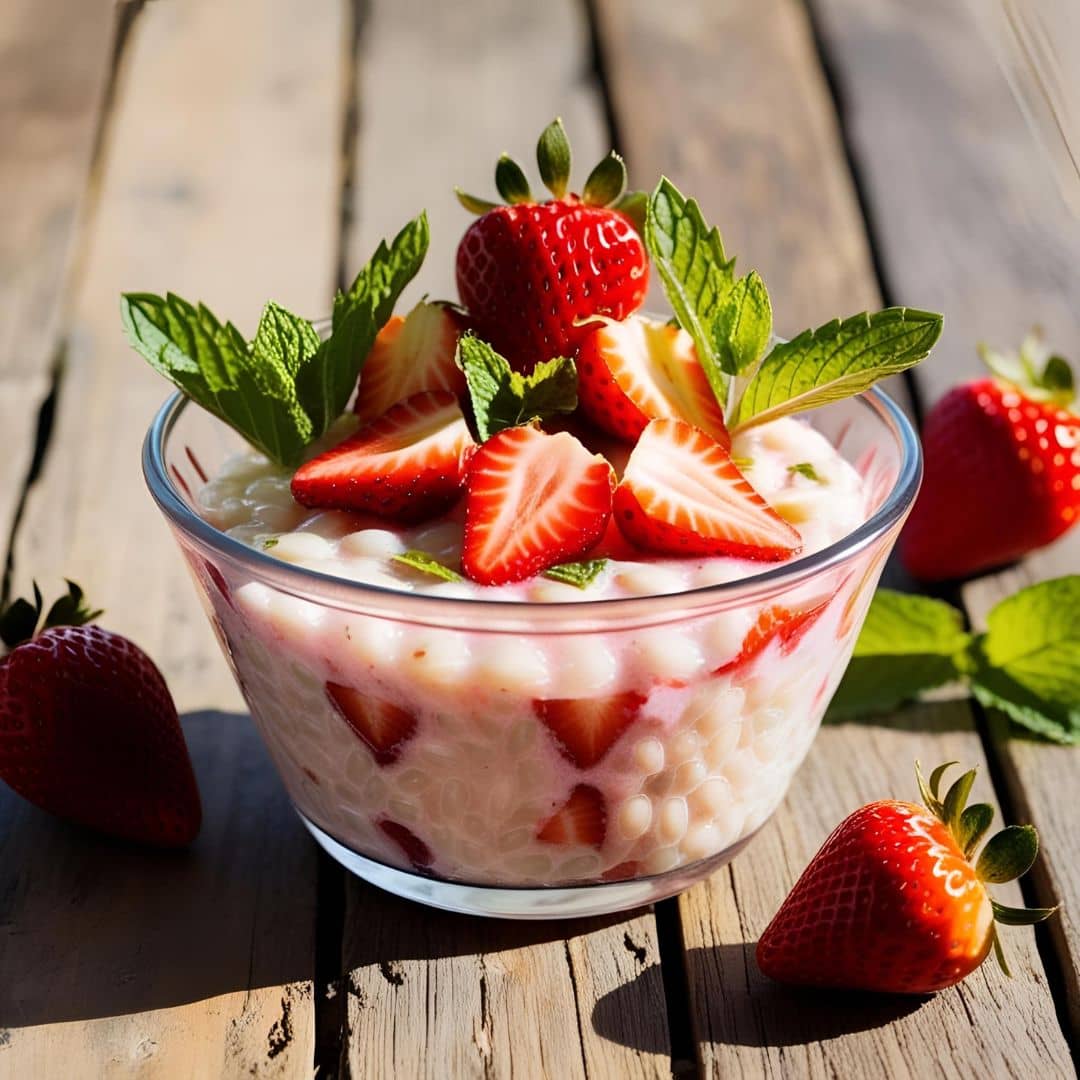Introduction
Strawberry Sago is a luscious, refreshing dessert that combines the chewiness of sago pearls with the sweet, tangy burst of fresh strawberries. This dish is beloved across many Asian countries and has recently gained popularity worldwide due to its vibrant appearance and delightful taste. Whether served chilled on a hot summer day or enjoyed as a light, fruity treat after a hearty meal, Strawberry Sago is a versatile dessert that caters to a wide range of palates.
The History of Strawberry Sago
The origins of sago-based desserts trace back to Southeast Asia, where sago pearls have been a staple ingredient for centuries. Derived from the pith of the sago palm, these tiny, translucent pearls are rich in carbohydrates and have been traditionally used in both savory and sweet dishes. The adaptation of sago with strawberries likely emerged as global trade introduced tropical regions to temperate fruits. The fusion of sago’s neutral, chewy texture with the vibrant, juicy strawberries created a dessert that’s both refreshing and satisfying. Over time, variations of this dessert have evolved, incorporating different fruits, sweeteners, and dairy alternatives.
Ingredients Breakdown
To prepare Strawberry Sago, you will need the following ingredients:
- Sago Pearls: 1 cup (small tapioca pearls can be used as an alternative)
- Fresh Strawberries: 2 cups, hulled and chopped
- Milk or Coconut Milk: 2 cups (for a richer, creamier texture)
- Water: 4 cups (for boiling sago)
- Sugar: 1/2 cup (adjust to taste)
- Condensed Milk: 1/4 cup (optional, for added sweetness and creaminess)
- Ice Cubes: For serving chilled
- Mint Leaves: For garnish (optional)
Step-by-Step Recipe
- Preparing the Sago:
- Rinse the sago pearls thoroughly under cold water.
- In a large pot, bring 4 cups of water to a boil.
- Add the sago pearls to the boiling water, stirring continuously to prevent sticking.
- Cook for 10-15 minutes until the pearls turn translucent, stirring occasionally.
- Once cooked, drain the sago and rinse under cold water to remove excess starch.
- Preparing the Strawberry Puree:
- Blend 1.5 cups of the chopped strawberries with sugar and condensed milk until smooth.
- Adjust the sweetness as needed based on the tartness of the strawberries.
- Combining the Ingredients:
- In a large mixing bowl, combine the cooked sago pearls with the strawberry puree.
- Add the milk or coconut milk, stirring well to ensure even distribution.
- Mix in the remaining chopped strawberries for added texture.
- Chilling and Serving:
- Refrigerate the mixture for at least an hour to enhance the flavors.
- Serve chilled in individual bowls or glasses, garnished with mint leaves and ice cubes.
Tips for the Perfect Strawberry Sago
- Consistency: Adjust the amount of milk or coconut milk based on your preferred consistency. For a thicker dessert, use less liquid.
- Sweetness: Taste the mixture before chilling and adjust the sugar accordingly. Strawberries vary in sweetness depending on the season.
- Color Enhancement: A few drops of natural beet juice can enhance the pink hue without altering the taste.
- Serving: For a fancier presentation, layer the sago mixture with whipped cream or yogurt in dessert glasses.
Variations and Customizations
- Mixed Berry Sago: Incorporate other berries like blueberries, raspberries, or blackberries for a burst of flavors.
- Mango Sago: Replace strawberries with mangoes for a tropical twist.
- Vegan Option: Use almond milk or soy milk instead of dairy milk.
- Nutty Crunch: Add a sprinkle of chopped almonds, pistachios, or coconut flakes for added texture.
Health Considerations and Nutritional Value Strawberry Sago can be a nutritious dessert when made with fresh ingredients and moderate sweeteners:
- Strawberries: High in vitamin C, antioxidants, and fiber.
- Sago Pearls: A good source of carbohydrates, providing quick energy.
- Milk/Coconut Milk: Adds calcium, vitamin D, and healthy fats.
However, it’s important to note that sago is high in carbohydrates with minimal fiber or protein. Moderation is key, especially for individuals managing blood sugar levels.
FAQ
- Can I make Strawberry Sago ahead of time?
- Yes, it can be prepared a day in advance and stored in the refrigerator. Just stir well before serving.
- Can I use frozen strawberries?
- Absolutely. Thaw them before blending for a smoother puree.
- Is sago the same as tapioca?
- They are similar but not identical. Tapioca is made from cassava root, while sago comes from the sago palm. Both work well in this recipe.
- How do I prevent sago from sticking together?
- Rinse thoroughly after boiling and occasionally stir while cooking.

Strawberry Sago
Ingredients
- Sago Pearls: 1 cup small tapioca pearls can be used as an alternative
- Fresh Strawberries: 2 cups hulled and chopped
- Milk or Coconut Milk: 2 cups for a richer, creamier texture
- Water: 4 cups for boiling sago
- Sugar: 1/2 cup adjust to taste
- Condensed Milk: 1/4 cup optional, for added sweetness and creaminess
- Ice Cubes: For serving chilled
- Mint Leaves: For garnish optional
Instructions
Preparing the Sago:
- Rinse the sago pearls thoroughly under cold water.
- In a large pot, bring 4 cups of water to a boil.
- Add the sago pearls to the boiling water, stirring continuously to prevent sticking.
- Cook for 10-15 minutes until the pearls turn translucent, stirring occasionally.
- Once cooked, drain the sago and rinse under cold water to remove excess starch.
Preparing the Strawberry Puree:
- Blend 1.5 cups of the chopped strawberries with sugar and condensed milk until smooth.
- Adjust the sweetness as needed based on the tartness of the strawberries.
Combining the Ingredients:
- In a large mixing bowl, combine the cooked sago pearls with the strawberry puree.
- Add the milk or coconut milk, stirring well to ensure even distribution.
- Mix in the remaining chopped strawberries for added texture.
Chilling and Serving:
- Refrigerate the mixture for at least an hour to enhance the flavors.
- Serve chilled in individual bowls or glasses, garnished with mint leaves and ice cubes.
Notes
- Consistency: Adjust the amount of milk or coconut milk based on your preferred consistency. For a thicker dessert, use less liquid.
- Sweetness: Taste the mixture before chilling and adjust the sugar accordingly. Strawberries vary in sweetness depending on the season.
- Color Enhancement: A few drops of natural beet juice can enhance the pink hue without altering the taste.
- Serving: For a fancier presentation, layer the sago mixture with whipped cream or yogurt in dessert glasses.

